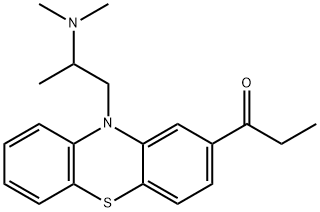aceprometazine
- CAS NO.:13461-01-3
- Empirical Formula: C19H22N2OS
- Molecular Weight: 326.46
- MDL number: MFCD00867747
- EINECS: 236-661-9
- SAFETY DATA SHEET (SDS)
- Update Date: 2024-11-19 23:02:33

What is aceprometazine?
Originator
Aceprometazine ,ZYF Pharm Chemical
The Uses of aceprometazine
Acepromethazine is a phenothiazine derivative that is often used in combination with Meprobamate (M227750) for the treatment of sleep disorders.
Definition
ChEBI: A phenothiazine compound having an acetyl group at the 2-position and a 2-(dimethylamino)-1-propyl group at the 10-position.
Manufacturing Process
In a 1 liter flask, equipped with stirrer, thermometer and nitrogen inlet, 241.0
g of 2-acetylphenothiazine (1 mole) is dissolved in 300 ml of dry
dimethylformamide. When the 2-acetylphenothiazine is almost completely
soluble, to this solution is added 275 ml of a 4 N solution of 1-dimethylamino-
2-chloropropane in toluene.
The mixture is heated to 50°C and 26.0 g (1.08 moles) of sodium hydride is
added portion-wise, maintaining the temperature at 50°-60°C. The addition
should take about 1 h. The reaction is allowed to stir for 3 h at 50°-60°C. Any
excess hydride is destroyed by the cautious addition of 10 ml methanol, and
the reaction mix is poured into 800 ml of 20% acetic acid.
The toluene layer is separated and extracted with 150 ml of 20% acetic acid,
and discarded. The acid solutions are combined and washed once with
toluene. The toluene is discarded. Fresh toluene (200 ml) is added and caustic
solution is added with cooling and stirring until the pH is 9 or above. The
toluene layer is separated. The aqueous layer is extracted once more with 75
ml of toluene and discarded. The toluene extracts are combined, given a small
water wash, and concentrated. The residue is distilled yielding 10-[2-
(dimethylamino)propyl]-2-acetylphenothiazine.
Therapeutic Function
Neuroleptic, Antitussive
Safety Profile
Poison by subcutaneous route.Moderately toxic by ingestion. A flammable liquid. Whenheated to decomposition it emits toxic vapors of NOx andSOx.
Properties of aceprometazine
| Boiling point: | 490.1±45.0 °C(Predicted) |
| Density | 1.1075 (rough estimate) |
| refractive index | 1.5950 (estimate) |
| solubility | Chloroform (Slightly), Methanol (Sparingly) |
| pka | 8.93±0.50(Predicted) |
| form | A liquid |
Safety information for aceprometazine
Computed Descriptors for aceprometazine
New Products
(S)-3-Aminobutanenitrile hydrochloride 4-Methylphenylacetic acid N-Boc-D-alaninol N-BOC-D/L-ALANINOL Tert-butyl bis(2-chloroethyl)carbamate 3-Morpholino-1-(4-nitrophenyl)-5,6-dihydropyridin- 2(1H)-one Furan-2,5-Dicarboxylic Acid Tropic acid 1-Bromo-3,5-Di-Tert-Butylbenzene S-2-CHLORO PROPIONIC ACID ETHYL ISOCYANOACETATE 2-Bromo-1,3-Bis(Dimethylamino)Trimethinium Hexafluorophosphate 4-IODO BENZOIC ACID 3-NITRO-2-METHYL ANILINE 1-(2,4-DICHLOROPHENYL) ETHANAMINE (2-Hydroxyphenyl)acetonitrile 4-Bromopyrazole 2-(Cyanocyclohexyl)acetic acid 4-methoxy-3,5-dinitropyridine 1-(4-(aminomethyl)benzyl)urea hydrochloride 2-aminopropyl benzoate hydrochloride diethyl 2-(2-((tertbutoxycarbonyl)amino) ethyl)malonate tert-butyl 4- (ureidomethyl)benzylcarbamate Ethyl-2-chloro((4-methoxyphenyl)hydrazono)acetateRelated products of tetrahydrofuran








You may like
-
 2033-24-1 98%View Details
2033-24-1 98%View Details
2033-24-1 -
 42831-50-5 5-METHYLISOXAZOLE-4-CARBOXYLIC ACID 98%View Details
42831-50-5 5-METHYLISOXAZOLE-4-CARBOXYLIC ACID 98%View Details
42831-50-5 -
 1975-50-4 98%View Details
1975-50-4 98%View Details
1975-50-4 -
 2-HYDROXY BENZYL ALCOHOL 98%View Details
2-HYDROXY BENZYL ALCOHOL 98%View Details
90-01-7 -
 2-Chloro-1,3-Bis(Dimethylamino)Trimethinium Hexafluorophosphate 221615-75-4 98%View Details
2-Chloro-1,3-Bis(Dimethylamino)Trimethinium Hexafluorophosphate 221615-75-4 98%View Details
221615-75-4 -
 61397-56-6 CIS BROMO BENZOATE 98%View Details
61397-56-6 CIS BROMO BENZOATE 98%View Details
61397-56-6 -
 14714-50-2 (2-Hydroxyphenyl)acetonitrile 98+View Details
14714-50-2 (2-Hydroxyphenyl)acetonitrile 98+View Details
14714-50-2 -
 118753-70-1 98+View Details
118753-70-1 98+View Details
118753-70-1